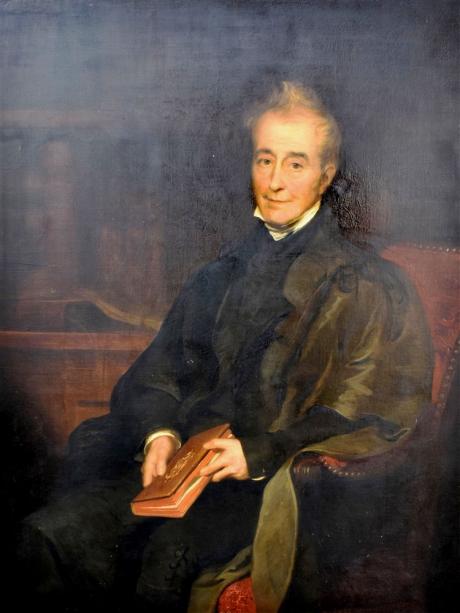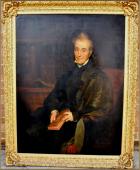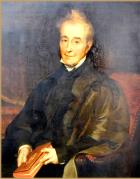inscribed on a labeld on the reverse " Charles Webb le Bas , principle of East India Co. College Haileybury- painted on his retirement 1844 by " Mr Morton Gt Gt Grandfather of Raleb"
From the collection of a descendent, Exmoor
Thomas Lewis Atkinson, after Andrew Morton, mezzotint, 1840s
Charles Webb Le Bas, (1779–1861), college head, was born at 20 New Bond Street, London, on 26 April 1779. He was descended from a Huguenot family at Caen, from which city his great-grandfather fled to England in 1702. His grandfather, Stephen Le Bas, was a brewer in St Giles-in-the-Fields, and his father, Charles Le Bas, a linen draper in New Bond Street. His mother was the daughter of Captain Webb of the East India Company's mercantile marine. She died when her son was only six years of age; about four years later the father settled at Bath, and afterwards at Margate. Charles was educated at Hyde Abbey School, near Winchester, where he was a contemporary of Thomas Gaisford.
In 1796 Le Bas entered Trinity College, Cambridge, where he obtained a scholarship, and was afterwards Craven scholar, members' prizeman, and senior chancellor's medallist in the university. In 1800 he graduated BA as fourth wrangler, proceeding MA in 1803. He was elected in 1801 to a fellowship of his college, which he held until 1814, when he married Sophia, daughter of Mark Hodgson of the Bow brewery, inventor of the famous India pale ale.
In 1802 Le Bas was admitted a student at Lincoln's Inn, and in 1806 was called to the bar; but deafness compelled him to abandon the legal profession. In 1808 he became tutor to the two sons of the bishop of Lincoln (Dr Pretyman, who afterwards took the name of Tomline), and took holy orders in 1809. He was presented by Pretyman to the rectory of St Paul's, Shadwell, in 1811, which he held until 1843. From 1812 until his death Le Bas was a prebendary of Lincoln Cathedral. In 1813 he was appointed mathematical professor and dean in the East India College, Haileybury, in succession to William Dealtry, a prominent evangelical. He became principal of the college in 1837 on the death of Joseph Hallet Batten (1778–1837), remaining there until increasing deafness and other infirmities led him to resign on 31 December 1843. Having responsibility for discipline over often unruly students, he was remembered by members of the college as a slightly comical figure with a high-pitched voice (Thomas, 15). But they signified their respect for his work at Haileybury by raising £1920 in 1848 to found the Le Bas essay prize at Cambridge.
Le Bas was distinguished as a preacher and as a writer. His published Sermons on Various Occasions (3 vols., 1822–34), chiefly delivered in the chapel of the East India College, were 'plain and practical sermons of a distinctly Anglican type' (DNB), indicating his influence as an 'antidote' to evangelicalism among future officers of the East India Company (Dewey, 156). He was a supporter of the Society for Promoting Christian Knowledge, for which he wrote several tracts. He was the author of the biography (2 vols., 1831) of his close friend Thomas Fanshaw Middleton, bishop of Calcutta, who shared his theological outlook, though his account omitted mention of Middleton's influence upon S. T. Coleridge. Associated with the group of high-churchmen known as the Hackney Phalanx, he belonged to the theological school that formed a link between the Caroline divines and the nonjurors and the Oxford Movement of 1833. That school included such Cambridge men as Hugh James Rose, Christopher Wordsworth, the master of Trinity College, Professor J. J. Blunt, and W. H. Mill. Christopher Wordsworth, afterwards bishop of Lincoln, in a journal kept during his undergraduate days, frequently speaks of the large congregations that assembled in the university church to hear Le Bas preach.
Le Bas was one of the principal contributors to the British Critic, and wrote nearly eighty articles for it between 1827 and 1838. In the latter year John Henry Newman became editor, and, despite their theological differences, he accepted four articles by Le Bas. Le Bas also contributed to the British Magazine in 1831–2, which was founded and edited by Hugh James Rose for the purpose of inculcating high Anglican principles. He contributed lives of Wyclif (1831), Cranmer (1833), Jewel (1835), and Laud to the Theological Library series, edited by Rose and W. R. Lyall. In 1846 he published a biography of his friend Henry Vincent Bayley, archdeacon of Stow.
Le Bas retired to Brighton, where he died at his home, 74 Montpelier Road, on 25 January 1861. Of his large family, whose additions had necessitated extensions to the domestic accommodation at Haileybury, only one son, the Revd Henry Vincent Le Bas, survived him.
Le Bas Prize
Old Haileyburians made a subscription in memory of his services there, and in 1848 endowed the Le Bas Scholarships (Bursaries)[2] at the University of Cambridge for the best students in the study of Literature.
Publications
Le Bas was of the theological school which bridged between the Caroline divines and nonjurors and the Oxford movement, with others such as Hugh James Rose, Christopher Wordsworth, John James Blunt, and William Hodge Mill. He was one of the contributors to the British Critic, and wrote nearly eighty articles for it between 1827 and 1838. He also contributed to Rose's British Magazine in 1831–2.
Le Bas's major works were:
- Considerations on Miracles, 1828, a reprint, with additions, of an article in the British Critic on John Penrose's Treatise on the Evidence of the Christian Miracles.
- Sermons on various occasions (3 vols. 1822–34)
- The Life of the Right Reverend Thomas Fanshaw Middleton, D.D.: Late Lord Bishop of Calcutta. C. J. G. & F. Rivington. 1831. pp. 1–.
- Memoir of Henry Vincent Bayley, 1846, another old friend.[3]
To the Theological Library, edited by Rose and William Rowe Lyall, Le Bas contributed five volumes:
- The life of Wiclif. Printed for J. G. & F. Rivington. 1832.
- The Life of Archbishop Cranmer. Rivington. 1833.
- The Life of Bishop Jewel. J. G. & F. Rivington. 1835. pp. 1–.
- The life of archbishop Laud. J.G. and F. Rivington. 1836. republished 2005 Kessinger Publishing ISBN 1-4179-5714-X
He was also author of tracts for the Society for Promoting Christian Knowledge, and published single sermons:
- Bas, Charles Webb Le (1836). A sermon [on 2 Cor. ii, 16] preached at the consecration of ... W. Otter ... bishop of Chichester
The East India Company College, or East India College, was an educational establishment situated at Hailey, Hertfordshire, nineteen miles north of London founded in 1806 to train "writers" (administrators) for the Honourable East India Company (HEIC). It provided general and vocational education for young gentlemen of sixteen to eighteen years old, who were nominated by the Company's directors to writerships in its overseas civil service.
The college's counterpart for the training of officers for the company's Presidency armies was Addiscombe Military Seminary, Surrey.
History

Charles Grant, Chairman of the British East India Company and Member of Parliament, was closely involved in the foundation of the college. It was first located in Hertford Castle but it was evident that a purpose-built seat of learning would be more suitable and in October 1805 the company purchased an estate just outside Hertford Heath for the sum of £5,930 for this objective. The foundation stone of the new buildings were laid on May 12, 1806. The buildings cost the East India Company £92,000 at the time of their erection to the designs of the architect William Wilkins (who later designed the National Gallery in London). The grounds were landscaped by Humphry Repton, his most notable work here being the terraced area to the front of Wilkins' main range and ponds to the west of this. Repton submitted his final account for work undertaken here just eight days before the carriage accident which left him crippled. The new buildings were occupied by students in 1809.
The East India Company had been incorporated in 1600 as a commercial entity. For two hundred years its administrators had been recruited, largely by patronage, to oversee commercial transactions in Asia. By 1800 they had become the de facto government for millions of people in those areas, but without much training for the role. The college was intended to address these shortcomings. In fifty years it trained over two thousand so-called "writers" to administer the Indian subcontinent.
The curriculum was wide, detailed, and targeted to the career responsibilities. It included political economy, history, mathematics, natural philosophy, classics, law and humanity and philology. Languages included Arabic, Urdu (Hindustani), Bengali, Marathi, Sanskrit, Telugu and Persian. Among the tutors were some of the finest minds of the day, many from Oxford and Cambridge, with lavish annual salaries as much as £500.
The college was customarily referred to as "Haileybury" in contemporary accounts, debates in the House of Lords and the House of Commons and by the administrators of the East India Company and the Colonial Civil Service. From 1839 the College had a journal known as The Haileybury Observer.
The East India Company itself was seen as too powerful. There was pressure for meritocracy to replace recruitment by patronage. Graduates of universities in Great Britain should have the chance to serve in India, without needing to pass through the college. In 1855, Parliament passed an act "to relieve the East India Company from the obligation to maintain the College at Haileybury". King's College, London, hosted the first open competitive examinations for appointment to the Indian Civil Service.
In January 1858, the college was closed. For a brief period the buildings became a military depot for troops destined for India. During this interregnum the college's Master, Revd Henry Melvill, and Registrar, Revd James William Lucas Heaviside, continued to live in their residences on the site and oversaw the maintenance of the buildings. The leading Hertford publisher Stephen Austin, who had been the official printer to the East India Company’s College and thus become one of the leading printers of books in various Oriental languages, led a campaign to ensure the buildings were returned to some sort of academic purpose and the college ultimately reopened as the public school Haileybury in 1862 (formally constituted by Royal Charter on August 30, 1864). During the Victorian era the difference between the two periods of education on the site were referred to as "Old Haileybury" and "New Haileybury". In its early years the new school retained close links to those involved in colonial administration and it would ultimately merge with the Imperial Service College in 1942 to become Haileybury and Imperial Service College.



